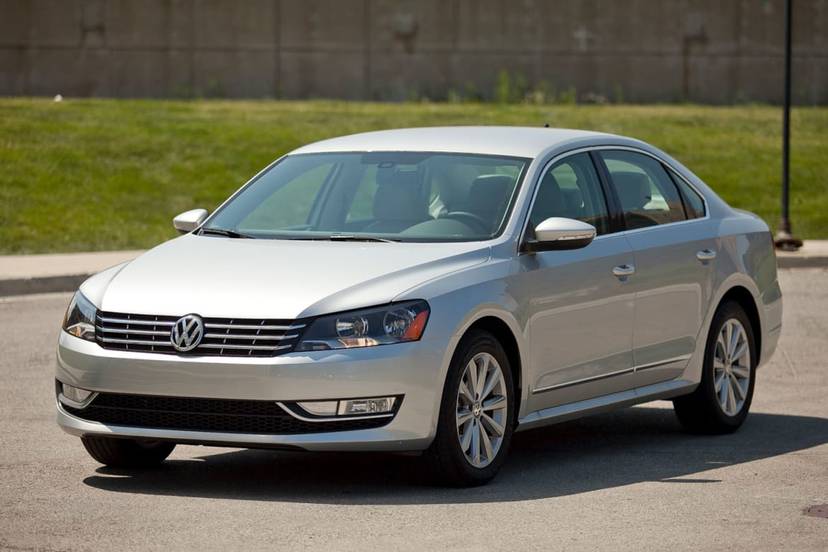
Volkswagen’s Passat has been a Cars.com Best Bet for years. We’ve praised its styling, upscale interior and array of versions, including sedan and wagon body styles and front- and all-wheel-drive models. A recent redesign further refined the Passat’s interior, which now treads remarkably close to those of Volkswagen’s luxury brand, Audi, further blurring the already fuzzy line between plebeian family haulers and upscale executive transporters.
Depending on what you’re looking for in an automobile, this can be a good or a bad thing. The Passat’s price of entry is steeper than much of its midsize competition, but if you’re not concerned about having a luxury brand logo on the hood, the Passat provides much of the ambiance of a luxury car for less dough, and how can that be bad?
Exterior & Styling
Volkswagen took a phased approach with the launch of the new Passat: The redesigned sedan debuted as a 2006 model and the revamped wagon entered the market as a 2007. One of its most visible features is a plunging, V-shaped front grille that bisects the bumper. Though not quite as arresting as Audi’s full-framed grille, it’s quite distinctive when finished in chrome. Already gracing the front of the GTI and Jetta, the design theme is likely to spread across Volkswagen’s product lineup. One downside: If you live in a state that requires a front license plate, the plate will likely mar the look of that front end.
I’m a fan of wagons, especially those that don’t pretend to be crossovers. So with that in mind, I’ll come out and say it: The redesigned Passat wagon looks great. Where the prior-generation’s styling was a bit ho-hum, the new wagon is sleek and aggressive in the sport wagon tradition. The optional 17-inch alloy wheels fill up the wheel wells nicely, and 18-inchers are available. The wagon’s sleek, flowing lines evoke thoughts of more expensive metal like BMW’s 5 Series wagon or Audi’s A6 Avant, and a power liftgate is standard. That said, I’d be interested to hear how you think it looks; send me an email with your thoughts.
Ride & Handling
Though it’s on the firm side, the Passat’s four-wheel independent suspension provides a nice balance between body roll control and bump absorption. A sport suspension is optional.
The wagon’s body structure doesn’t feel as solid as the sedan’s when driving over rough pavement, and both the sedan and wagon I tested were afflicted with a number of interior rattles. Steering effort is thoroughly light, and it feels like the wheel is connected directly to a giant ball bearing; it’s that smooth, and wouldn’t be out of place in a Lexus sedan. A side effect of the highly boosted power steering system, however, is that steering feedback has largely been eliminated.
Though it can be hustled through corners, the Passat feels more at home cruising on the highway, where it eats up the miles. Wind noise at 70 mph is practically nonexistent, and ambient noises from semi trucks are sufficiently quieted. It’s the kind of car you can step out of after driving for half a day and not feel worn out — probably one of its best attributes.
Going & Stopping
The Passat is available with a choice of two gas engines, which are detailed below.
| Volkswagen Passat Engines | |||||||||||
|---|---|---|---|---|---|---|---|---|---|---|---|
| Turbo 2.0-liter four-cylinder | 3.6-liter V-6 | ||||||||||
| Horsepower | 200 @ 5,100 rpm | 280 @ 6,200 rpm | |||||||||
| Torque (lbs.-ft.) | 207 @ 1,800 rpm | 265 @ 2,750 rpm | |||||||||
| Required fuel | Premium unleaded | Regular unleaded | |||||||||
| EPA-estimated gas mileage (city/highway, mpg)* |
22 – 23/31 – 32 | 18 – 19/26 – 28 | |||||||||
| *City and highway fuel economy ranges are attributable to transmission and driveline variations; the four-cylinder can drive a manual or automatic transmission and the V-6 can work with front- or all-wheel drive. Source: Manufacturer |
|||||||||||
Both engines are competent performers. The turbocharged 2.0-liter four-cylinder is very smooth and provides adequate acceleration when teamed with the six-speed automatic transmission. It’d probably be easier to wring more power out of it with the standard six-speed manual.
Volkswagen offers a 3.6-liter narrow-angle V-6 for those who want more power. Whereas many V-6s make peak torque between 4,000 and 5,000 rpm, the 3.6-liter V-6 generates 265 pounds-feet of torque at a low 2,750 rpm, making it very accessible in everyday driving situations. It is a torquey beast, and it induced some torque steer in a front-wheel-drive Passat during full throttle acceleration. Even when cruising at 60 mph, there is plenty of passing power in reserve. Despite these attributes, the V-6’s idle is rougher and noisier than expected, though it does smooth out once you depress the gas pedal.
While the turbocharged 2.0-liter four-cylinder can team with either a six-speed manual or a six-speed automatic with a clutchless-manual mode, the 3.6-liter V-6 only drives the automatic. For the most part, it’s a smooth-shifting unit, but accelerator lag tarnishes its otherwise-skillful performance — so much so that I would think twice about opting for the 3.6-liter V-6 if I were in the market for this car.
Lag is most evident after braking to a halt for a stop sign or some other situation followed by immediate acceleration. Only after the gas pedal is pressed for a half second or so does the car respond by surging forward. I might have chalked this up to an annoying quirk if it didn’t happen regularly, but it did. Interestingly, throttle lag isn’t a problem following longer stops, like at a stoplight.
Passats have all-disc brakes that are easy to modulate and provide strong stopping performance. An electronic parking brake is standard.
The Inside
Passat sedans and wagons can hold up to five people, and Volkswagen’s attention to detail and high-quality materials give the cabin a rich feel. The amount of wood trim on my test car’s dashboard seemed excessive, though, and the rearview mirror in one of the Passats I drove felt flimsy when I tried to adjust it.
These are small quibbles, and when taken as a whole the cabin is a pleasant space. Aside from an ungainly seam on a front door panel, fit and finish levels are high and panel gaps are tight — probably a little too tight in some instances. When I activated the hazard lights, the dashboard button became caught in the surrounding wood trim and only released after I’d fiddled with it for a couple of minutes.
Simulated leather seating surfaces are standard and perforated leather seats are optional. The front seats provide firm support and modest bolstering, and have exceptional rear travel — it wasn’t difficult to find a comfortable driving position. The dead pedal, or footrest, is well placed for comfort, and Passats have a manual tilt/telescoping steering column.
All models have a 60/40-split, folding rear seat with a pass-thru to the cargo area, but their operation differs between the sedan and wagon. The sedan’s rear seatback folds down to reveal a sizable opening to the trunk that has minimal bulkhead intrusion. Expanding the cargo floor in the wagon requires that the seat cushion first be flipped up and out of the way before folding the seatback down. The extra step of flipping up the seat cushion means that tall drivers will have to give up some space in order to make room for the backrest to fold down. Interestingly, it’s possible to fold down the backrest without flipping forward the seat cushion and still have an almost-flat load floor. I suspect that’s what most owners will end up doing to avoid the burdensome part of that dance.
Not surprisingly, the wagon’s backseat feels roomier than the sedan’s, with decent legroom for adults. Both versions have respectable foot space under the front seats, but the sedan has an upright backrest and a knees-up seating position. As might be expected, the center rear seat is not especially comfortable, and passengers sitting here have to find room for their feet on each side of a big floor hump. Optional manual sunshades for the rear side windows and a rear sunshade (sedan only) are a feature that’s been traditionally reserved for luxury vehicles, but it’s well worth having, especially if your passengers include infants.
Safety
Standard safety features include antilock brakes with automatic disc wiping to keep brake discs dry and clean in wet conditions, an electronic stability system, side-impact airbags for the front seats, side curtain airbags, and LATCH child-safety seat anchors for each outboard seat. Though the center rear seat — the best place for a child-safety seat — lacked anchors, it was easy to use an anchor from each outboard seat to tightly secure a child-safety seat. Rear-seat side-impact airbags are optional.
As a result of its Good overall scores in the Insurance Institute for Highway Safety’s frontal-offset and side-impact crash tests, and an Acceptable overall rating for rear crash protection, the Passat was given the Institute’s Top Safety Pick 2006 (silver) award.
Cargo & Towing
Selecting the wagon over the sedan more than doubles the Passat’s cargo volume: The sedan has a 14.2-cubic-foot trunk, while the wagon’s cargo area measures 35.8 cubic feet. The Passat is not rated for towing.
Features
Complete feature and specification information is available on the Standard Equipment & Specs page; I’ll touch on a few of the noteworthy options here.
Audiophiles should consider the optional Dynaudio sound system, which delivers strikingly clear, rich sound. Its $1,000 price tag could buy a lot of audio equipment for your home theater, but if you want that kind of sound quality on the road, the Dynaudio system delivers. The optional DVD-based navigation system is less impressive, proving more difficult to use than Toyota’s system in the Camry.
Other options include adaptive bi-xenon headlights that swivel in concert with the steering wheel, rain-sensing windshield wipers and front and rear parking sensors that emit an audible warning tone when approaching an object. Adaptive cruise control is newly optional for 2007.
Passat in the Market
As an owner of a prior-generation Passat sedan that I used as a daily driver, I can attest to that car’s solid structure, engaging personality and comfortable ride. That generation’s reliability has been less than stellar, however; the highest overall reliability score it’s received from Consumer Reports is average, with a number or worse than average ratings and even one much worse than average. Fortunately, it’s never left me stranded during the course of its 100,000-plus mile life, but it has had its share of electrical issues: The engine temperature gauge occasionally swings wildly back and forth for no apparent reason, and the climate control system’s backlighting has gone completely dead, among other things.
It will be interesting to see how the new Passat fares in this regard, because if it proves to be a hassle-free, reliable car, its winning attributes — a stylish interior and exterior, strong powertrains, attention to detail and safety ratings — will shine through.
| Send Mike an email |


































